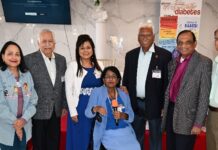
CHICAGO: The Aurora-based Illinois chapter of the Jeeyar Educational Trust (JET), headquartered in New Jersey, hosted a collective ritual performance of the “auspicious marriage of Lord Rama and his consort Sita” (Sita Rama Kalyanam) conducted by Sri Chinna Jeeyar Swamiji.
Preceded by an afternoon program of devotional songs and South Indian classical dances, this out of turn event took place on September 7 at Harper College located in Palatine, a northwest suburb of Chicago. The large number of registered participants filled the entire width and length of the gymnasium.
Chinna Jeeyar Swami is a “wandering monk” who belongs to the Vaishnava spiritual lineage of philosopher and reformer Acharya Shree Ramanuja. He walked between the rows distributing images of Rama, Sita, Lakshmana, and Hanuman, before explaining the philosophy underlying Hindu image-worship through a familiar idiom appealing to the American and Christian sensibility that did not hesitate to draw on the Bible.
Inspired by his message and example, JET provides humanitarian services including schooling for tribal, fishermen and the visually challenged and runs traditional Vedic, Agama and Vedanta schools. All services, education, books, board and lodging and healthcare facilities are provided free of cost to all. It also runs a hospital,
Besides Indian community leaders, those present included Illinois State Rep. Michelle Mussman (D) and Manju Goel, a Republican candidate for Illinois District 8, whose campaign was officially launched.
The cultural program in the afternoon featured songs and dances that had episodes from the Ramayana for their theme. Minoo Pashupati affiliated to the University of Chicago, presented a chorus of mostly girls led by a white American who played South Indian temple pipe (nadaswaram). Director of Nrityanat Dance Academy, Poonam Mahesh performed a Bharata Natyam duo with her award-winning student Joshua George to the Tamil composition (keerthanam) “Nee Uraipai Hanumane” set to Ragamalika and Adi thalam (rhythmic cycle).
Radhika Ramakrishnan, a student at Vijayalakshmi Shetty’s Chicago-based Nataraj Dance Academy, depicted nine (aesthetic) sentiments (rasa), namely humor, wonder, love, fear, anger, sorrow (instead of the traditional disgust), heroism, (pathos understood here as) compassion, and tranquility through nine select Ramayana episodes in Navarasam, the Tamil lyrics.
Director of Lasyasudha Dance Academy Sudha Kalavagunta performed an Annamacharya composition followed by a Sanskrit song from Jayadeva’s Geeta Govindam in Kuchipudi style. Hema Rajagopalan’s Natya Dance Theater performed Govindan Kuzhalosai or “the music of Krishna’s flute” (Tamil) in Ragamalika. The last item before Swamiji’s sermon was Jaya Jagadeesha Hare by Shobha Natarajan and her group which described the incarnations of Lord Vishnu.
Swamiji began his sermon explaining Vishnu (from root vish-) as God in his all-pervasive aspect and Rama as “beauty” from (ramayati). Citing the Bible that “the kingdom of God is within You” to underline that Vishnu dwells within, he recounted the parable of the old lady who lost her sewing needle and kept searching for it under a street lamp on the opposite side of the road. Our required lamp is the scriptures and Guru.
The purpose of puja was to initialize this process within oneself. To perform Sita-Rama-Kalyanam is to invoke the “wedding” of Rama’s supremacy and Sita’s compassion within us. Swamiji then led the collective performance of the ritual, explaining the minutest details regarding the various items of worship, the gestures (mudra), incantations (mantra), etc., and their meanings.
Asian Media USA






